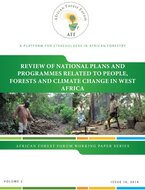National Plans and Programmes related to People, Forests and Climate Change in West Africa were reviewed in a desk study, in order to improve understanding of how forests and trees, and the people who depend on them, respond to climate change and variability. The study focused on National Adaptation Plans/Programmes of Action (NAPAs), National Climate Change Strategies, Nationally Appropriate Mitigation Actions (NAMAs) and National Communications to the UNFCCC, and sought to identify gaps and factors influencing their implementation, and how these could be filled through forestry and forestry-related interventions. The study also examined the profiles and capacities of public forest administrations in the studied West African countries, in terms of human, financial and physical capacities for effective monitoring, reporting and verification in the implementation of multilateral environmental agreements related to forestry and climate change, as well as the extent of participation of women, youth and vulnerable groups in forest based climate change response actions and how these could be enhanced. All countries in West Africa are parties to the UNFCCC and the Kyoto Protocol. All, except Liberia, have submitted their Initial/First National Communication and 11 of them have
submitted the Second National Communication. All 15 Least Developed Countries (LDCs) in the sub-region have submitted NAPAs and two of the non-LDCs have elaborated national adaptation strategies with implementation plans. Only six of the countries have responded to the Copenhagen Accord requirement for submission of Nationally Appropriate Mitigation Actions (NAMAs). Common constraints to implementation of the plans are shortage of funds and human resources, poor knowledge base and institutional bottlenecks. For many countries the involvement of forestry is not explicitly highlighted in their climate change response plans. Along with harnessing external support to improve financial and technical capacity, and applying the funds gained to building human (by education and training), research and institutional capacities, recognition of the role of forestry, and investment to strengthen this role will have a widespread positive influence in achieving the goals of many of the listed climate change response measures in the sub-region.
Only Burkina Faso and Senegal have good forest inventory capacity. Niger has some, but the rest of the countries have limited or very low forest inventory capacities Also, the majority (12 out of 18) of the countries studied have very low forest area monitoring
capacities, as judged by shortcomings in consistency, transparency, comparability, completeness and accuracy of reports they have returned to bodies such as FAO, UNFCCC and the World Bank. Most (11) of the countries with low forest area monitoring capacity are among the LDCs. It is suggested that the low capacities observed partly reflect a long tradition of neglect of inventory, monitoring and reporting in forest practice in most African countries, including the West African countries studied. The capacity building required to overcome this is not just in terms of skills, tools and facilities, but also in terms of national re-orientation, and particularly of the forestry services. Except in countries where cultural norms restrict women from taking part in field activities,
women, youth and the poor traditionally participate actively in forestry activities, including those done in response to climate change, e.g. nursery work, planting tree seedlings, watering and tending seedlings as well as monitoring agroforestry practices and protecting naturally regenerated seedlings. Women and youth also dominate in collecting, processing and marketing non-timber forest products (NTFPs). To increase the roles and benefits to women, youth and vulnerable groups in forest-based climate change response programmes, emphasis should be given to developing NTFP-based enterprises into a viable commercial industry sector that can take advantage of international market opportunities. Designing the emerging REDD+ mechanism to accommodate such a development, accompanied with policy reforms to address constraints to women’s participation in forestry, such as restricted land and tree tenure rights, poor representation of women in important decision-making structures and poor access to information, will help to sustain the increase in participation and benefits to women from forest-based responses to climate change. Arising from the findings of this study, critical areas for further attention by AFF would be: to conduct a more detailed assessment than was feasible in the present study, to identify specific forestry interventions, and how to implement them, in the priority NAPA projects and climate change response strategies and actions developed by West African countries, with a view to recommending such interventions to the relevant countries; to organise a programme of sensitisation, re-orientation and training of West African countries on the importance of forest inventory, monitoring, reporting and verification of forest cover changes in implementing sustainable forest management and forest-based responses to climate change; and, to initiate and promote research into the development of NTFP-based enterprises into a viable commercial industry sector dominated by women and youth and linked with the implementation of forest-based climate change responses such as the REDD mechanism or in NAMAs in West Africa countries.

